GASTROTURF
Long walks in old shoes to food, vine & drama, plated up
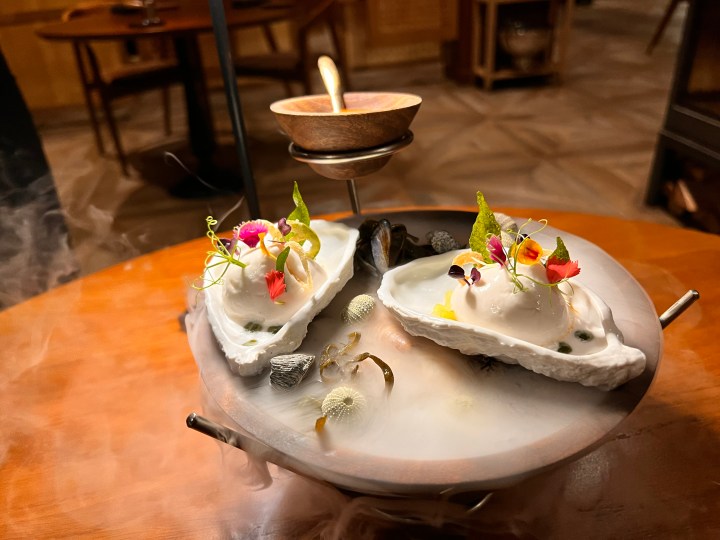
The shoes we walk in take us through the times of our lives. Like ants we touch one another and move on, then find one another again when least expecting to. Along the way there’s food, wine, laughter and stories worth telling. Sometimes the drama even ends up on the plate, as it did at a fabulous dinner recently.
Strange, the roads we walk, when we don’t know we’re walking them. A young man takes a footstep in a vineyard in France, with no thought of where he will step next as his tread follows him through a long life, or the brushstroke his hands will paint in response to a command from his thoughtful, faraway eyes.
Somewhere in the Eighties, a young man walks into a hotel on a Cape Town city square, and meets a garrulous older man with a nose for wine like no other. After that lunch, the same young man rounds a corner from Church Street into St George’s Street and turns to respond to a man calling his name. “Tony!” And a smile and a chat on the kerb.
The first young man is Achim von Arnim, the force behind Cabrière and Pierre Jourdan wines, a thousand works of art and a million stories worth telling. The footstep he takes is in a French vineyard, and that sole is still with him now; the sole of that very shoe.
The second young man is me, taking a footstep out of the office and walking into a restaurant at the Inn on the Square in Cape Town, to join a man called Achim von Arnim and others at a table for reasons I don’t recall. It would have had to do with a wine story of some kind, and also at the table was David Biggs, then my colleague in the Argus arts and features department and a wine columnist, before he became The Wanderer and brought out many wine and liquor books. Achim was then at Boschendal, becore Pierre Jourdan and all of the Franschhoek wonders happened.
The third is a man of theatre who, back then when St George’s was still a street, not yet a paved mall, had offices further down the road. One of my favourite “contacts”, he would call me often for a chat about theatre and he’d take me for lunch at Floris Smit Huijs (after the Bonthuys days), and of course I knew he was in search of publicity for his shows but even so they were a lot of fun because he is a superb conversationalist, we both have a way with words and a shared wry sense of humour, and I have always had strong opinions and never been ashamed to state them. So we could really talk.
That’s a thing in journalism; the unlikely relationships that happen along the way. You meet and get to know people you never would have met outside of this Fourth Estate. Mostly, they remain back-pocket relationships, and you know to keep them in their place. You understand the difference between a friend and an acquaintance. But slowly you learn that time plays a role until you find, after years and even decades, that a rare few of those relationships have attained a deeper meaning. The distance between you has eroded; common humanity has played its part.

A scene-setting Cape-flavoured aperitif at Epice. (Photo: Tony Jackman)
There’s a third thread to this story, and a place. The third thread is not a person as such, but a hotel, or rather an auberge as it has been known for a long time now, and a restaurant, or several in fact, then and now. First a restaurant called Le Quartier Français, now two restaurants (Epice and Protegé), but various incarnations in between. The place, as you will have guessed by now, is Franschhoek.
If not a particular person, this thread of an interlaced story has several. It is populated chiefly by John Huxter and Susan Huxter, and by Margot Janse, and now is peopled by others I do not know. But I have been back to find out how things are now, and I see Susan in her rich travels on Instagram, and it seems to me that, since selling to the Leeu Collection, she has achieved a stage of her life when the inordinate hard work she put into her years of owning Le Quartier Français have rewarded her with these travels and times of getting something back after having put in so much for so long. I have always had great respect for her.
John Huxter, who when he was married to Susan was also the chef at the restaurant and a lauded one at that, is no longer on my periphery though he is the only serious chef that I know of who ever visited my Sutherland restaurant, circa 2007, and said he enjoyed his meal of slowly roasted beef shin. Margot had stepped into the breach and ultimately became one of the world’s most lauded chefs, and deservedly, but her innate modesty and humanity seem to have played a role in her stepping out of the limelight and doing excellent things for children in need. I have never forgotten the poached fish dish Margot made soon after she took over the helm in the Le Quartier kitchen. Poached, not on the heat, but in warm olive oil on the hob. Just utterly superb. That was the moment when she was poised to become the culinary force she became.
Now I’ve come to Franschhoek again, and I am at Haute Cabrière with the complex creative soul we call Achim, man of bold thoughts, bolder art, undiluted charm and yet a delicate hand with the vine, and the ever smiling, ever patient Hildegard von Arnim and my family and there, on the wall, is that footprint. The sole of the shoe Achim trod as a young man in a French vineyard, a framed trophy marking a moment when a man trod the soil in which vines grew and went on to tread other soil, far away, and to bring us beautiful wines, with special attention (in my humble opinion) to the wines we are not supposed to call Champagne and to pinot noir, for which Cabrière is rightly famous. And my favourite, Ratafia, his fortified chardonnay which is represented in the cover image of my book, of a dish called Ratafia Figs. But I am nervous to describe any of his wines in any detail because Achim’s opinions are rooted as deeply in the soil as the most ancient oak of Vergelegen and even less likely to be uprooted.
Earlier in the day, though, my family had brunch at Tokara Deli (a croque madame with poached eggs, but it did not meld together and become “one” in the way a croque monsieur or madame should; it was nice, but was really a cheese and ham toasted sandwich with a pleasant cheesy sauce). The rainy morning was brightened by happy time spent with family and the random sight of a familiar figure walking into the deli: my theatre impresario friend from the Eighties, who I have seen on and off over what now are five decades, and who had come to join an actor we’d recognised at a table near us.
You don’t do that thing (I hope) of approaching famous people in restaurants and telling them how much you have always admired their work and could you have their autograph. You do say hello to people you know, though, even if it was with a little embarrassment because I had promised this man of a thousand productions that we would have lunch next time I was in Cape Town and here I was, and we hadn’t, and I was leaving the next morning. But I will next time without fail, he made me promise, and I hereby promise in print that I will, on pain of an erudite tongue lashing, have lunch with him next time and we will talk of many things and gossip about even more. If I haven’t named him it is only because, despite his prominence, he is one for the shadows, a figure in the wings, and keeps to himself in public as best he can.
I’ve taken long roads with him since a bottle of Chivas Regal first landed on my desk a few days before Christmas in the late Seventies. There’d be one every year for many Christmases after that. That was his way. It’s where my taste for whisky was born. It is my favourite tipple today, if not Chivas itself. I took it with soda in the early days; just a wee drappie of water will do now.
But this road, by the end of that Sunday, had brought me back to Le Quartier Français, to sleep in one of its fine suites for the first time since Susan Huxter first renovated it in the Nineties with her distinctive pastels, a style I could never tire of. And to dine at Epice, which occupies the large space where Margot Janse served so many brilliant dishes. Last I was there was near the end of her time there, when she was specialising in African flavours and ingredients, magnificently. Intriguingly, there turns out to be something of that in the cuisine, today, of the young chef who now reigns in that kitchen, Charné Sampson, though the space itself is unrecognisable. She is all about Cape spices, but in ways that I have not tasted in the food of any other Cape chef. Interestingly, John Huxter liked to play with the spices of the Cape too, with French touches, so there is a coincidental back story here that comes from John via Margot and to Charné.
It transpired that my encounter with the man of the boards that morning was far from the only theatre of the day. Sampson’s way with food blows all of the senses away. Presentation and colour worthy of a Chagall. Flavour upon tantalising flavour and as much variety in texture. Tricksy theatrical touches, yes, of the kind that I sometimes complain about. But they’re entirely justified when what you taste is even better than the vapours and eye-thrilling flourishes, or when the intake of breath as a lid is lifted to reveal the glories within is bested by the joy of eating it.
When I get irritated with tricksy presentation is when you’re left, after the smoke has dispersed, with a dish that has no way of matching its expectation.
They don’t waste time with the Full Spice Journey menu at Epice. After a cocktail aperitif from the drinks trolley, a Cape Malay style mojito with turmeric, ginger, lime, pineapple and Bacardi (we calculate that the server wasn’t yet born when I first went there in John Huxter’s day, when Achim tied my shoelaces on the steps as I left after a chef’s table in John’s kitchen, right there), the first of 11 (yes) courses arrives with aplomb. It’s a Saldanha Bay oyster dressed in vindaloo sauce, with a Tiger’s Milk espuma (it’s Spanish for foam, they could just call it that), cucumber, apple, chilli, turmeric, coconut cream, coriander, and extra vindaloo sauce served in a pot alongside. It was served with a well matched super-dry and citrusy Black Elephant Vintners NV Brut.
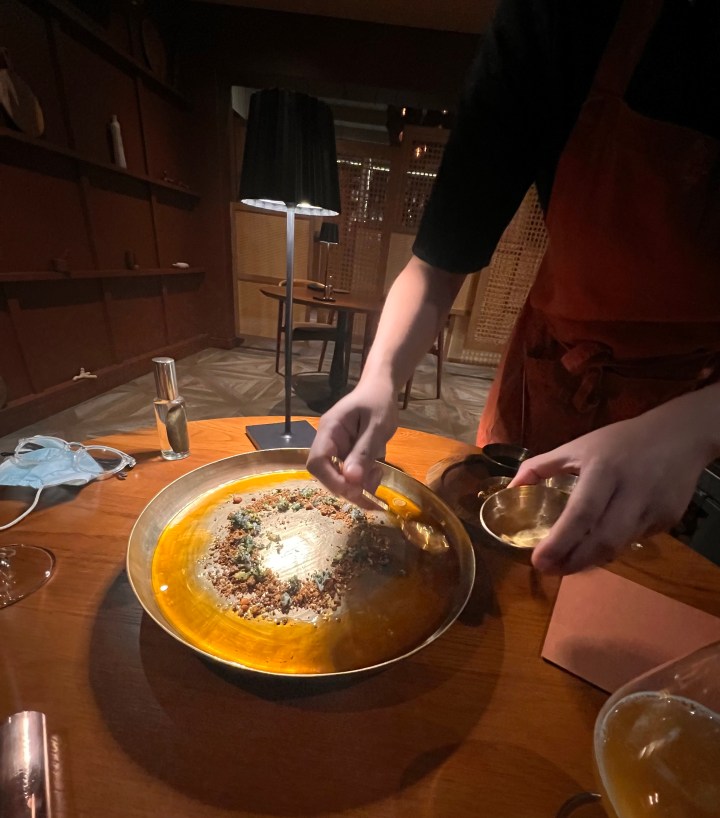
Charné Sampson brings “the bread course”: sweet potato and caraway bread. But it’s a thousand times more than that. (Photo: Tony Jackman)
That scene-setter is followed by the course that cannot be beaten, for this son of Yorkshire parents brought up to appreciate beef drippings with the Sunday roast. It’s entitled “caraway, beef drippings, hawaij, cinnamon” and a bemasked chef Charné Sampson herself brings it to the table, describing it modestly as “the bread course”: sweet potato and caraway bread. But it’s a thousand times more than that. There’s a metal hot tray (like a thali) into which she pours Wagyu beef drippings, from Purdon farm in the Eastern Cape, and hawaij spices, a Yemeni blend which typically contains black pepper and cumin with cardamom, turmeric, cinnamon and coriander and she has added caraway, white sesame seeds and cashews. There’s parsley too, as well as lemon, and red onion, to cut through the richness of the rice wine vinegar. To round out the meaty flavour is a jus from roasted bones cooked down with onions, port, medium sherry and white muscadel. To appreciate all that, just look at the picture: you dip that bread in and you’re in heaven. I so wish my mom could have tasted that. It was served, sensibly, with craft beer. Unquestionably one of the finest courses I have eaten in a long life. I would go back for that alone.
Next you’re invited to the kitchen for the “Chef’s Table”, to be taken through the assembling of a one-bite nibble of cold-smoked duck liver parfait with plenty of Szechuan notes and radish micro herbs. It’s a grand theatrical interlude and a chance to see the kitchen at work up close.
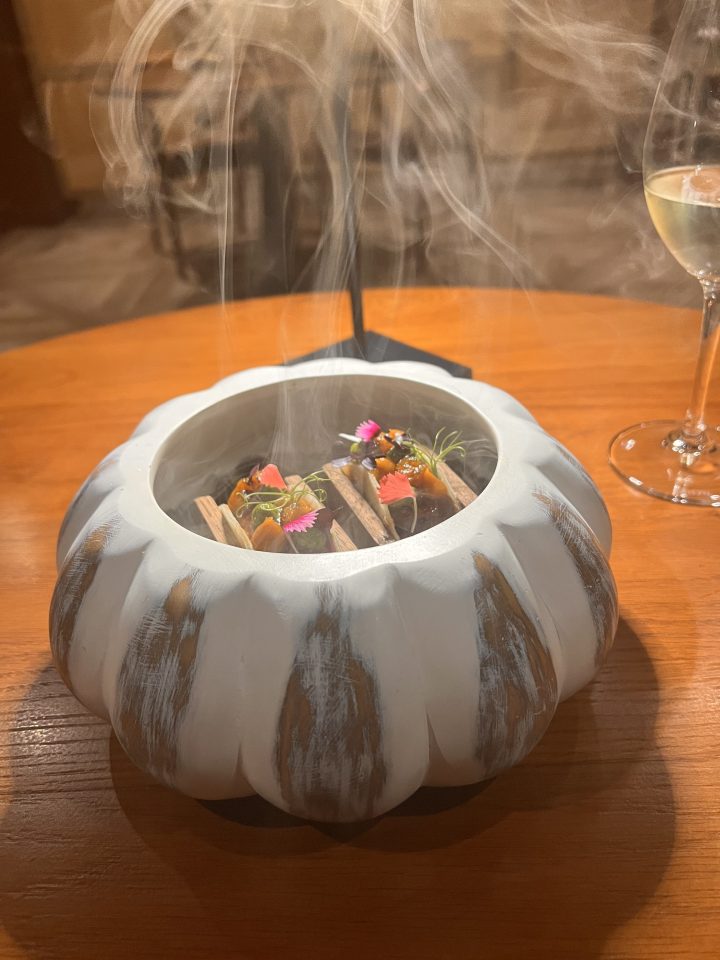
Chicken Korma roti reimagined. (Photo: Tony Jackman)
A Hartenberg Riesling is served with the next course of korma-glazed chicken roti on kashmiri chilli mayonnaise topped by coriander pesto and pumpkin leaf masala. The most dramatic course yet, but again even better to eat and taken by hand, with hand towels provided. But the most beautiful dish of the night is the tuna and avocado with cumin and mustard, pineapple, chilli and crispy “slangetjies”, like the ones you buy at the local café, served with a suitably complex Keermont Terrasse white blend.
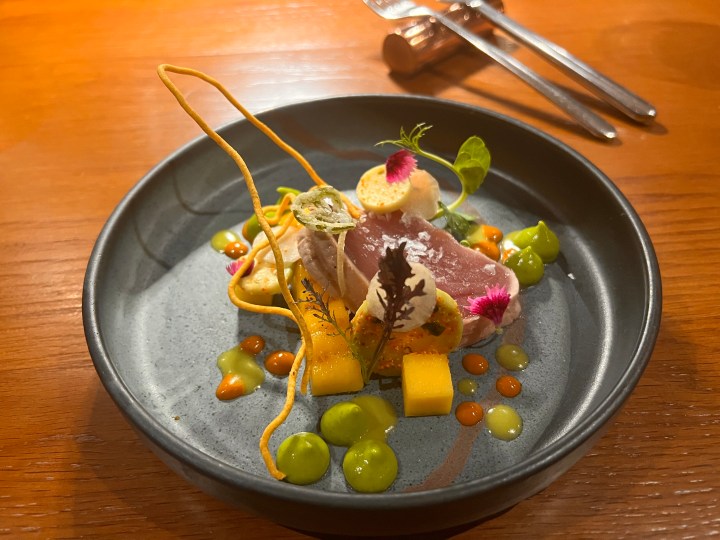
Rare tuna and ‘slangetjies’. (Photo: Tony Jackman)
A Fable Mountain Night Sky blend of syrah with grenache and mourvedre from Tulbagh accompanied the glazed pork belly with prawn and corn purée; delicious, but with everything else going on I thought it might be one course too many. Beef and foie gras were yet to come, after all.
A sorbet trolley provides a sweet break from it all, and again, it’s a show-offy thing as iced wonders in bright colours and pretty shapes are revealed to whet the palate for the seafood and grass-fed beef courses to come. It’s clear, already, that if everything from the preceding eight courses had been piled on one plate there wouldn’t be much room for anything else.
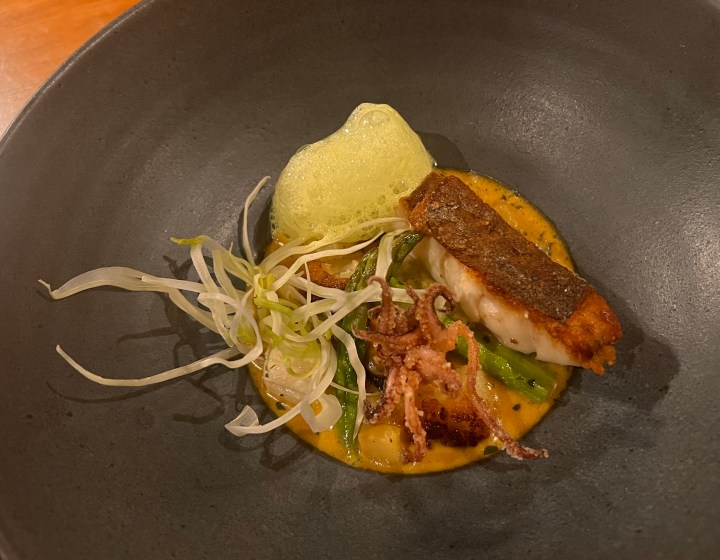
Kabeljou, squid, creamed leeks and fennel. (Photo: Tony Jackman)
But I persevere and the Foodie’s Wife gamely accepts the challenge of the next two plates but admits defeat before the cheese and dessert courses and the final extra fillip of a “Spice Test”.
The linefish is kabeljou served on creamed leeks, with fennel, squid and mussel, continuing the chef’s theme of playing with spices of the Cape, served with a Rousseau wooded sauvignon blanc from Elgin.
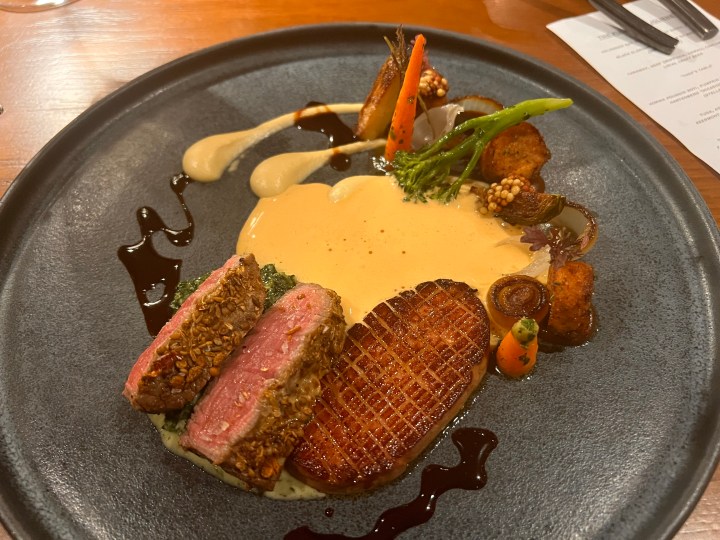
A generous portion of grass-fed beef, considering it was one of 11 courses. (Photo: Tony Jackman)
A 2015 Nico van der Merwe bold red cabernet sauvignon/shiraz blend comes out with the grass-fed beef fillet which is “resting” on creamed spinach and foie gras (such a rare treat), with spiced gnocchi, artichoke, pickled red onion, cabbage purée and, oddly, peri peri spice.
Backsberg Pinneau, fortified with potstill brandy, proved a heady match for the cheese course, which came before dessert. Puzzling at first: a crumble, brioche, sundry bits and pieces served in the round, and then the melted Langbaken cheese is poured in the centre and it all makes sense.
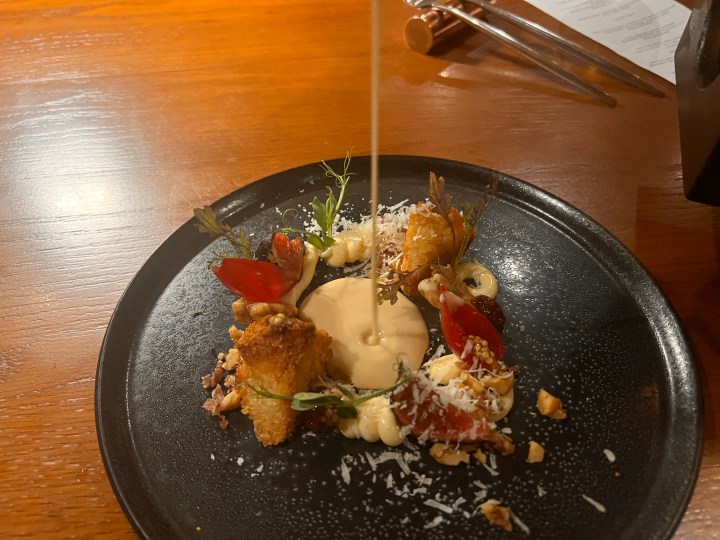
Molten Langbaken cheese brings a disparate dish together. (Photo: Tony Jackman)
The dessert course brought delights in flavours of strawberry, almond, vanilla and the inevitable spice (fivespice this time), and the “spice test” was a trio of morsels, ostensibly petit fours, but each with a particular flavour. You had to match whatever was on the palate with the scrawled cinnamon, star anise and vanilla on a slip of paper, and identify them. I did get them all correct, and they weren’t exactly hard to identify, although with every flavour in the world having recently passed the palate, it’s perhaps a small miracle that one could tell the vanilla apart from the star anise or, for that matter, whatever was in the glass at that point. Time to go back to the swanky Le Quartier Français suite, which is beautiful even if it lacks that special Susan Huxter touch of disparate pastels it once had, which it does, and dream dreams of old times and places and of people who have grown from young to old, just as I have. Sweet dreams. DM/TGIFood
Tony Jackman is Galliova Food Champion 2021. His book, foodSTUFF, is available in the DM Shop. Buy it here.
Follow Tony Jackman on Instagram @tony_jackman_cooks. Share your versions of his recipes with him on Instagram and he’ll see them and respond.
SUBSCRIBE to TGIFood here. Also visit the TGIFood platform, a repository of all of our food writing
Tony Jackman was a guest of Leeu Collection.






 Become an Insider
Become an Insider
Eloquent as ever, Tony – although, in such a paean to the gastro-roots of today’s ‘Hoek, a brief nod to the extraordinary Adré MacWilliam-Smith (and husband, Arthur) would have been most appropriate… for it was this brave couple who sparked the first flickerings of Maillard magic that would make Franschhoek the foodie mecca that it is today.